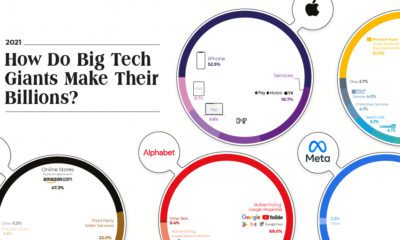After COVID-19 hit hard in March, tech companies started to see their customer bases and revenues grow at an increased rate as people were stuck at home and utilizing their services. Since down markets are the perfect time to consolidate, 2020 also saw big tech companies take the opportunity to grow their business with major mergers and acquisitions (M&A). After a quieter year in 2019 that saw tech investment activity dip, it was a resurgence to expected form. In this graphic, we visualize the year’s biggest tech deals above $1 billion using data from Computerworld, which tracked the year’s biggest acquisitions.
Deal Activity from the Get-Go
Though 2020 was all about COVID-19 and its impact on the market, the tech sector had major deal flow even before the pandemic began. By the end of February, six of the 19 biggest tech mergers and acquisitions of the year had already occurred—and the month of February alone saw the most major deals of any month with four. The first deals of the year were also some of the biggest. Morgan Stanley’s purchase of online brokerage E*TRADE for $13 billion and Koch Industries’ $11 billion completed takeover of software company Infor were the 4th and 5th biggest tech acquisitions of 2020. Other big moves included purchases from tech and payments firms Salesforce, Visa, and Intuit, as well as private equity firm Insight Partners.
The Biggest 2020 Deals Were Saved for Last
After a quiet March, only a few large deals occurred from April to the summer. Nvidia’s $6.9 billion purchase of network chip producer Mellanox Technologies in May was more than a year in the making, and Uber’s $2.65 billion acquisition of food delivery rival Postmates in July significantly consolidated the U.S. food delivery scene. As it turned out, the biggest deals of 2020 were back-loaded for the end of the year. Just under half of 2020’s billion-dollar tech M&As happened from September‒December, including the year’s three largest tech acquisitions: Of the 19 deals over $1 billion tracked above, Salesforce and Nvidia were the only companies to make multiple major acquisitions. And although tech saw gains across the sector, most of the major M&A activity was centered around semiconductors. As 2020 winds down, the market focus on tech is expected to last into 2021. However, the markets and the world at large continue to deal with COVID-19. The rollout of vaccines has put the world on a timeline to reach a post-COVID era. How will the tech landscape be affected? on But fast forward to the end of last week, and SVB was shuttered by regulators after a panic-induced bank run. So, how exactly did this happen? We dig in below.
Road to a Bank Run
SVB and its customers generally thrived during the low interest rate era, but as rates rose, SVB found itself more exposed to risk than a typical bank. Even so, at the end of 2022, the bank’s balance sheet showed no cause for alarm.
As well, the bank was viewed positively in a number of places. Most Wall Street analyst ratings were overwhelmingly positive on the bank’s stock, and Forbes had just added the bank to its Financial All-Stars list. Outward signs of trouble emerged on Wednesday, March 8th, when SVB surprised investors with news that the bank needed to raise more than $2 billion to shore up its balance sheet. The reaction from prominent venture capitalists was not positive, with Coatue Management, Union Square Ventures, and Peter Thiel’s Founders Fund moving to limit exposure to the 40-year-old bank. The influence of these firms is believed to have added fuel to the fire, and a bank run ensued. Also influencing decision making was the fact that SVB had the highest percentage of uninsured domestic deposits of all big banks. These totaled nearly $152 billion, or about 97% of all deposits. By the end of the day, customers had tried to withdraw $42 billion in deposits.
What Triggered the SVB Collapse?
While the collapse of SVB took place over the course of 44 hours, its roots trace back to the early pandemic years. In 2021, U.S. venture capital-backed companies raised a record $330 billion—double the amount seen in 2020. At the time, interest rates were at rock-bottom levels to help buoy the economy. Matt Levine sums up the situation well: “When interest rates are low everywhere, a dollar in 20 years is about as good as a dollar today, so a startup whose business model is “we will lose money for a decade building artificial intelligence, and then rake in lots of money in the far future” sounds pretty good. When interest rates are higher, a dollar today is better than a dollar tomorrow, so investors want cash flows. When interest rates were low for a long time, and suddenly become high, all the money that was rushing to your customers is suddenly cut off.” Source: Pitchbook Why is this important? During this time, SVB received billions of dollars from these venture-backed clients. In one year alone, their deposits increased 100%. They took these funds and invested them in longer-term bonds. As a result, this created a dangerous trap as the company expected rates would remain low. During this time, SVB invested in bonds at the top of the market. As interest rates rose higher and bond prices declined, SVB started taking major losses on their long-term bond holdings.
Losses Fueling a Liquidity Crunch
When SVB reported its fourth quarter results in early 2023, Moody’s Investor Service, a credit rating agency took notice. In early March, it said that SVB was at high risk for a downgrade due to its significant unrealized losses. In response, SVB looked to sell $2 billion of its investments at a loss to help boost liquidity for its struggling balance sheet. Soon, more hedge funds and venture investors realized SVB could be on thin ice. Depositors withdrew funds in droves, spurring a liquidity squeeze and prompting California regulators and the FDIC to step in and shut down the bank.
What Happens Now?
While much of SVB’s activity was focused on the tech sector, the bank’s shocking collapse has rattled a financial sector that is already on edge.
The four biggest U.S. banks lost a combined $52 billion the day before the SVB collapse. On Friday, other banking stocks saw double-digit drops, including Signature Bank (-23%), First Republic (-15%), and Silvergate Capital (-11%).
Source: Morningstar Direct. *Represents March 9 data, trading halted on March 10.
When the dust settles, it’s hard to predict the ripple effects that will emerge from this dramatic event. For investors, the Secretary of the Treasury Janet Yellen announced confidence in the banking system remaining resilient, noting that regulators have the proper tools in response to the issue.
But others have seen trouble brewing as far back as 2020 (or earlier) when commercial banking assets were skyrocketing and banks were buying bonds when rates were low.













